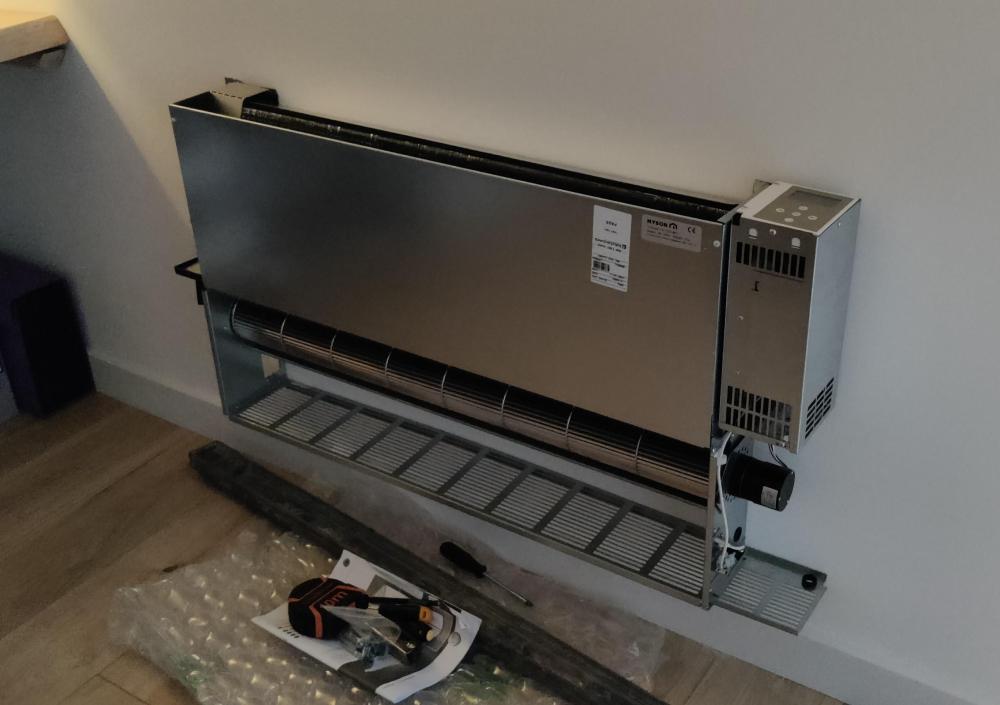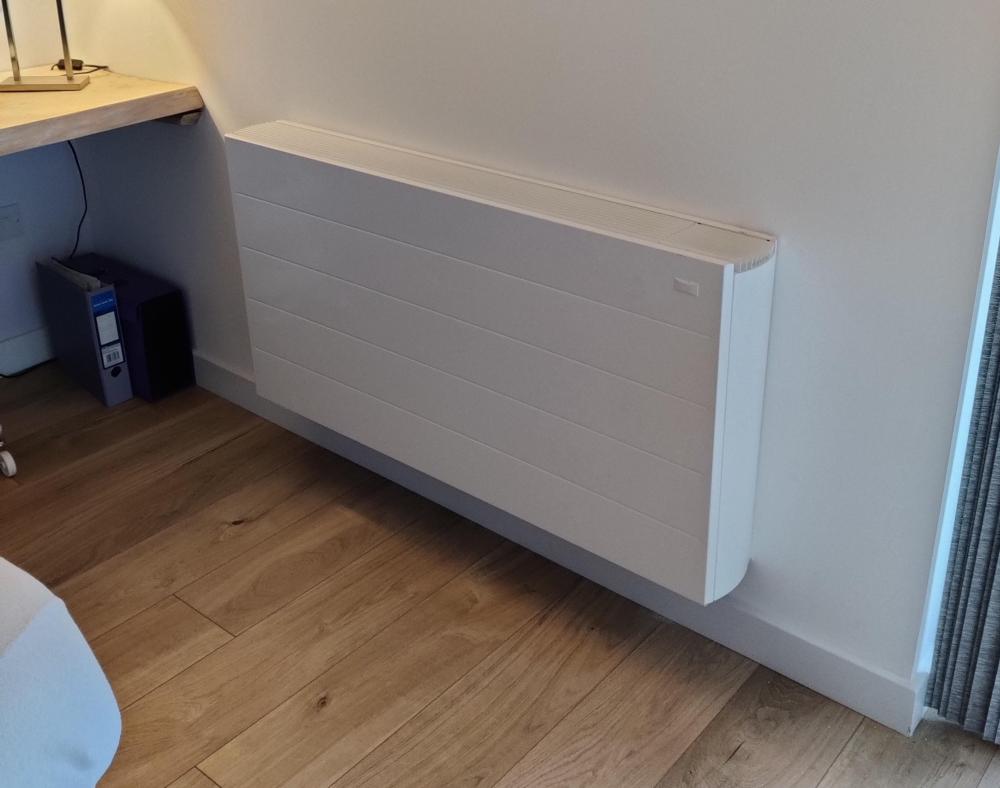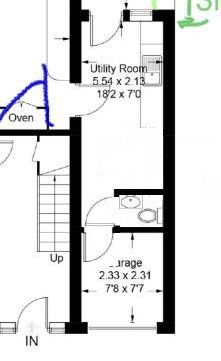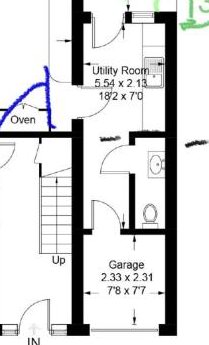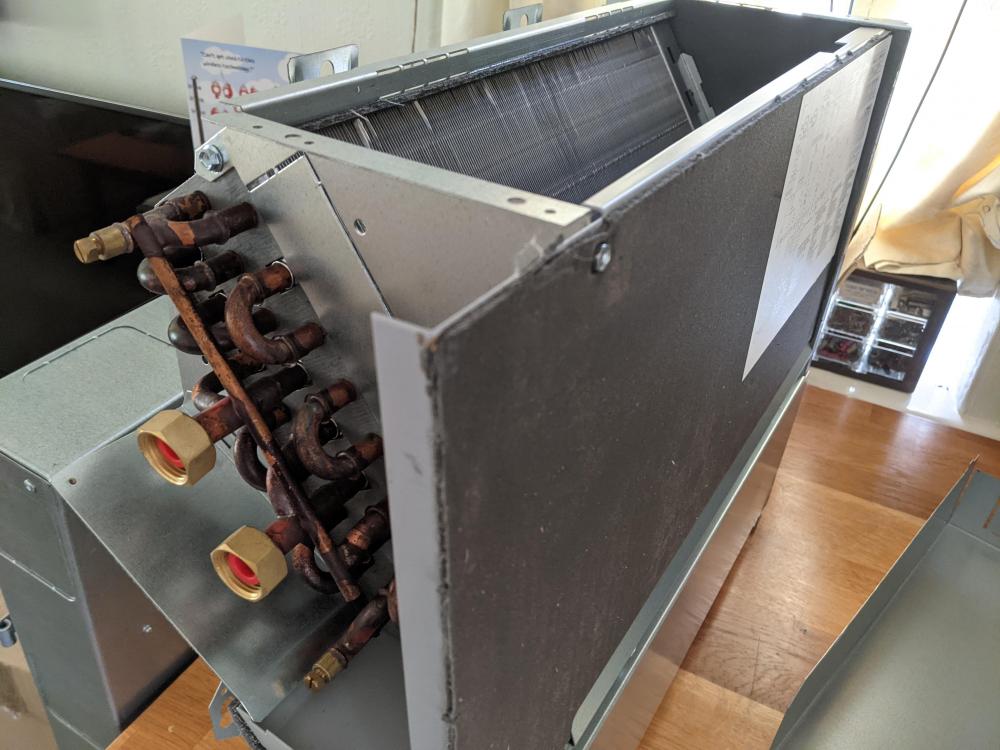Leaderboard
Popular Content
Showing content with the highest reputation on 01/13/24 in all areas
-
Many thanks to all the contributors. This is what makes this forum so useful, a lot of varied information from knowledgeable people. I have decided not to insulate the wall and risk any deterioration. There is no sign of damp or mould, even near the bottom of the wall, so I shall keep it as it has been for the last fifty years even though I shall lose the advantage of having insulation.2 points
-
Fan coil being installed in garden room to replace UFH, which really didn't work well unless at flow temperatures. Which wasn't an option with the ASHP and the main house heating demand. So Christmas eBay search led to me buying a Myson iVector MkII fan coil 1.2m wide. This unit can do heating and cooling and has a variable fan cut in temperature, so should allow me run weather compensation. Unfortunately the unit needs to placed on the opposite side of the summer house to the existing water entry point. So instead of running pipes internal, have decided to run them externally. Some photos of progress Unit wall mounted Cover installed The unit I got is a 4 pipe fan coil. This unit has a dedicated cooling and seperate heating heat exchangers. The heat transfer area of the combined heating and cooling HE's is about 50% larger than a 2 pipe fan coil. Have piped the two HE's as a single unit. I am using a Salus self balancing actuator to balance the flow rate through the fan coil. Have started the external piping using 15mm Hep2O and 25mm wall thickness insulation. The insulation to aluminium tape covered to keep mice away and UV to stop sun damage. The pipes sit on metal brackets 40mm off the ground and are galvanised banded into place.1 point
-
Well done you for giving this a go.. If you want I can give you a few pointers on what you need to do to get the preliminary sizes for you timber frame (TF) and the grades of timber you may need. To do that I would need to know.. A: The floor plan dimensions, location of the internal load bearing walls roof pitch and need to know about any funny loads you are introducing.. pool tables ect.. B: The ground, first and second floor levels. C :The sizes of the openings.. windows and doors. D : Your post code so I can assess the wind and snow loading. I'm minded to give this a go with my SE hat on as.. 1/ You have made a good effort. 2/ It may help other folk on BH understand what goes into the preliminary sizing of a timber frame.1 point
-
If you strip the topsoil along with all the vegetation, and pile it high, then it rots and is nicer topsoil to put back down. Ie don't bother separating out the vegetation. Find out about the soil makeup and water table ASAP, before any commitment to building an inside out swimming pool.1 point
-
1 point
-
The SSR has a very small load on the DC input side. I've never actually measured it but it can't be significant compared to the LED strips1 point
-
I hate to say it, but seems more like hopium than a solution. Is there any proper research as to the long term performance. Yes. The French Réhafutur 1 research project (http://www.rehafutur.fr/) was the initial research project, a collaboration between the housing association Maisons et Cités and the University of Artois, with support from the regional Eco-business Creation and Development Association (CD2E), the French Building Federation, the Federation of Construction Employers Cooperatives, and others. It's 60 miles inland from Calais, south of Lille, so a similar climate to southern UK. The 4 elevations were insulated with different materials: 300mm hempcrete blocks in thin-bed lime mortar, with the gap against the brick wall filled with hemp fibre (so functionally similar to the in-situ hempcrete linked to above) 350mm blown-in cellulose fibre 350mm flax wool 360mm sheep wool There's some brief info here in English - https://www.isohemp.com/en/hemp-solution-heritage-renovation and a video of the insulation here in French: https://www.youtube.com/watch?v=QkR4WATzp0Q The building was monitored by the regional Civil Engineering & géo-Environnement Laboratory (LGCgE) using 80 probes, measuring temperature & heat flow (on the internal surfaces, external surfaces, and boundary between insulation and structure of the external envelope), temperature & hygrometery (in the centre of the insulation), ventilation air flow & internal air quality. Energy use was logged and the external weather measured. Various metrics were calculated including actual -v- predicted U-values, thermal inertia and thermal decoupling; plus acoustic performance, materials wastage, embodied energy, cost effectiveness, environmental life cycle analysis, etc. The outcome of this (and a subsequent pilot) was that the hempcrete was judged the optimal solution for wall insulation. As a result an initial 50 houses were insulated with hempcrete in Pecquencourt a couple of years ago (to be increased to 115), with a plan to expand that to 1,000 by around 2026, and eventually more as the local production capacity and knowledge are developed. There's some info on these plans in English here: https://batinfo.com/en/actuality/le-bailleur-maisonscites-lance-lexperimentation-pecquenchanvre_19931 and a video in French here: https://www.youtube.com/watch?v=7u8gxdJP_pU1 point
-
You've opened a can of worms here! The Scottish regs are a little different but here is another part of the English regs: This is where it gets complicated by the need for open plan living. Let's say you have a stair leading up from a single storey basement onto the ground floor (GF) area that has a kitchen / open plan area, then another stair leading up to attic rooms. Now you can't make a protected corridor as you have that open plan GF. I agree with you all but just digging into this in my own way. Lets go back to basics. If a fire starts somewhere you need to get from the apartment you are in (usually a bedroom or principle living space, bathrooms are excluded as you should not be in them that long! as are other parts where you may not be spending a lot of time in.. balances occupancy rate with time spent = risk to a place of safety (outside normally for a house) without having to essentially go though another room then a corridor to exit the building. Now if you have an open plan kitchen on the GF that is a big fire risk.. you could get easily get disorientated and trapped in the basement. Remember, few folk have been in a fire and when panic sets in folk can behave in odd ways. In terms of saving lives. It's the smoke that kills most folk. I've not yet delved too deep into the English regs yet but in Scotland the regs have recognised that lots of developers want an open plan space on the ground floor. To get round this we are using sprinkler systems (the ones that don't need a big storage tank) and often what we call enhanced grade D fire protection. I don't think the English regs are requiring sprinklers yet. An enhanced grade D system often means we put smoke / heat detectors everywhere and get it serviced by a professional, that includes the consumer unit cupboard.. anywhere a fire could possible start and interlink them all. The idea is to detect smoke as soon as possible, then heat... as by the time there is heat there tends to be a lot of killing smoke. Now if you are intending to use your basement as a plant room only then the regs get relaxed I think. As I said I've not checked that part of the English regs yet. But to call it a plant room you can't go putting wall paper up and a bar with the full optics and 40 oz bottles of your choice etc! But pragmatically if you're going to be down there a lot I would want another way out if push comes to shove. Maybe a light well with an opening window that you could get out and clamber up to ground level.. you would have an element of encouragement especially if your pants were at risk of going fire! You could navigate the regs by keeping the basement as a plant room / storage space but still keep you safe. In this my guess is that you would need a fire door at basement level to protect the area above. In the round for me it's about creating a safe space for all your family and visitors. Yes comply with the regs.. but also apply common sense.1 point
-
Ours was all bolder Clay Hence the expense I payed a deep six inch drain across the field 100 meters With four chambers each with land drains running from them that seems to work ok1 point
-
I think that order is the important bit, from an ecological point of view. The only thing to be careful is if it is clay subsoil, water runoff could be a problem.1 point
-
The problem is the velocity is too high. Can you put a small ball of chain in the gutter above the chain and hope it does not clog up.1 point
-
There's a magic height for fill of 4 feet at which planning matters can kick in. Or if you are in a conservation area. Otherwise it is good practice to avoid muck away. Where else would it be going? A much more effective way to reduce cost is to not have a basement.1 point
-
Fix the roof rather than changing the bucket. I may have a look for the excellent explanatory sketch of moisture in a masonry wall...but I think I said that a week ago.1 point
-
Then just crack on, you cannot be expected to not build and I am sure the planners will not see this as a reasonable objection1 point
-
Hi there. I totally agree and we approached them months ago and showed them the plans. Interestingly they never mentioned this as an issue and have only done so as a formal objection. Looking on Google Earth their seating area is about 20m away from the double storey aspect of our build (the lower parts won’t be any different as there is a 3m hedge.) I really don’t feel that the area the actual area they use with be affected but a small area of the patio will. Worth noting their patio is huge and takes up the full width of their 25m wide garden.1 point
-
Very unlikely to carbon steel, will be copper or stainless. Towel rad strong suspect1 point
-
Lets be realistic, how are you going to retrofit a DPC to a house? (please dont say a chemical DPC, thats utter bollocks and nothing but a scam)Especially one of stone and rubble infill construction? Please, come back to the real world. Having the wall allowing water to evaporate faster than it gets in is how old houses with no DPC work. Sadly, of course, it didnt always work. There were no calculations to do that way back when. It was hit and miss. The really bad stuff has invariably long since gone. Short of demolition, you have to accept and work WITH it if you want a damp free house. When i did my last house, i admit i was sceptical too. But removing the inappropiate material completely fixed things. When i started the walls were so wet, the socket back boxes had corroded away (in 10 years) and if you drilled a hole in the wall it came out as a slurry. Stripped the plaster off, repointed the outside in lime to replace the cement, removed the concrete slab on mud. In a matter of weeks, it was completely dry, to the point drilling a hole in the wall at ground level produced dry brick dust. Frankly, it was quite amazing to watch over the weeks. At the new place, which is stone with much thicker walls, we uncovered the fireplace early on. It had been pointed in cement. The bottom 2 feet some of the stones were dark and wet to touch. Chipping out the motar revealed the lime behind that in places was so wet, you could push your finger into it. Its taken 6 months this time (and the outside is still painted and pointed in cement) its dried out. The motar is hard, well as hard as lime ever is, stones have all dried out. Ive only repointed a small section so far. Again, practical real world experience. Which for me wins over hypothesis.1 point
-
Ok thats clear. Either/or. A protected route will always be the aim if the layout allows.1 point
-
It's an insurance policy - it says "Certificate of Insurance" on the top of ours. It's limit is for a total value of the reinstatement at the time, so will not increase with inflation. I am sure in the event of major claim there will be toing and froing between them and the provider of the Buildings Insurance. We only took one out as we were going for a mortgage.1 point
-
It reminds me. The building regs used to be in a huge lever arch file. A couple of times i took this in to heavy meetings with a bco, and placed it on the table at the start. I could see their discomfort immediately. They knew that at some stage i would refer to it, or ask them to show me where it said what they were arguing. Only when they were being unreasonable or plain wrong. Only with LA ones as it happens. Fire protection of a basement stair was one such.1 point
-
Simple but effective Check List from the Vent Axia Installation Manual More to it than that, such as the ducting should be rigid with a small section of flexi and that trap shows a wet trap. Flexi creates more turbulence which will affect performance / electric efficiency and more noise, also more likely to cause duct build up. Also more prone to damage.1 point
-
Before you go spending a lot of time and effort could I point out my recent experience with a mini-split. I had assumed that the cooling effect would be like the heating but just the opposite way round. Not so, when heating the effect is very localised but when cooling the cold air sinks down and spills across the floors. So one little mini-split is cooling the whole of our ground floor.1 point
-
Oh, dear lord!! No. Try the opposite. Architects draw great pictures, and then say "oh, it's 5 o'clock, bye" when it gets down to anything regarding technical detail / insulation / airtightness / and any slight hint that they may need to calculate or consider plant space and mechanical thoroughfares etc, and they're gone faster than you can say " where's the architects car gone?" when you spot their oversights / omissions. Wrong professional for this I'm afraid. You'll be able to get bags of info from here tbh, just start bashing away at the search facility and topics and get stuck in . Put the time and effort in doing your own research and then you won't need these people. Ask questions here and the answers will soon follow1 point
-
1 point
-
So given the challenges with the politics we probably do need ashps with a high turndown ratio so they can manage without a buffer tank, self learning controllers so that relatively untrained installers can fit and forget and the controller will sort itself out with sensible weather compensation etc. without the (untrained) customer having to intervene. Plus a solution to the dhw problem which doesn't involve the major disruption of retro-fitting a uvc caused by the tundish/drain arrangement. If these problems can be cracked an ashp becomes no more difficult to fit than a gas boiler at which point (if we can also get the price right) we don't need politicians to make unpopular decisions for change to happen. The good news is that none of that seems technologically difficult, but the industry seems to innovate at a snails pace so sadly it could be a long time unless a disruptor emerges.1 point
-
I agree about smaller newbuilds. But for retrofitting, which is about a 30 million homes, compared to 200k new builds a year, there is usually room. The nation has to start to understand that there will not be the option of a small box, hanging on the kitchen wall, supplying all the house heating. Those days are vanishing fast. So no point throwing the baby our with the bathwater, most existing houses could have an ASHP.1 point
-
Well 6 months on we finally got this working! I won't quite say commissioned yet, as we're still running the FTC6 in single zone for fan coil + ufh, but now the plumbing is all complete I can think about getting the control systems properly working. (I say plumbing is complete, there's still a broken flow sensor to replace) Progress has been so slow with our MCS installer I actually got my main contractors plumber to help me debug the fan coil yesterday. The issue was obvious, looking at that photo above the red things in the threaded connectors are bungs. Kinda important you remove those before hooking it up, else no water ain't flowing anywhere. Would have been nice if the MIs has mentioned that! Being in the loft, this is obviously the highest point in the system by quite some way, so bleeding the system has to happen here. It has manual air release vents but it'd be nice to have automatic ones (or a system fill point up there next to it) to allow single person system pressurisation. Anyway, bit of a faff but I think this is really going to pay off come summer. It's amazing how no one at all on our build has ever seen anything like it. Thanks RHI random restrictions. They're so common on the continent. Glad I read about it here. In a pinch a plinth heater would also have worked I think, but for cooling we'd have to DIY build a condensation tray and ensure it doesn't get into the electrics.1 point
-
Is it like when the local TV news talks to 'the public'. It's who they can find in the high street at 2.00 on a wet Tuesday, that is prepared to state an opinion. The interesting and informed people are doing something useful somewhere.0 points
-
Polymer cement mortar Edit Polymer cement mortars (PCM) are the materials which are made by partially replacing the cement hydrate binders of conventional cement mortar with polymers. The polymeric admixtures include latexes or emulsions, redispersible polymer powders, water-soluble polymers, liquid thermoset resins and monomers.[16] Although they increase cost of mortars when used as an additive, they enhance properties. Polymer mortar has low permeability that may be detrimental to moisture accumulation when used to repair a traditional brick, block or stone wall. It is mainly designed for repairing concrete structures. The use of recovered plastics in mortars is being researched and is gaining ground.[17] Depolymerizing PET to use as a polymeric binder to enhance mortars is actively being studied.[18][19][20]0 points





